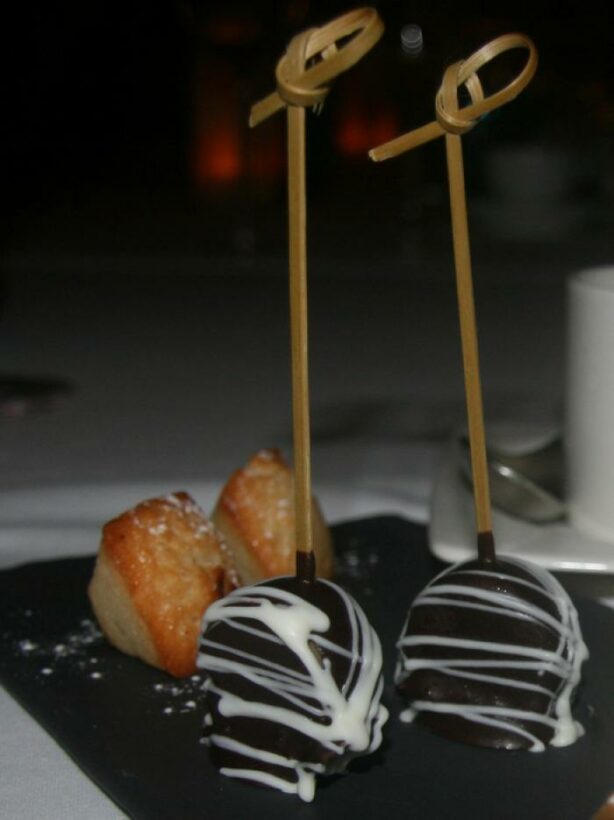Foie gras lollipop steals the spotlight at Trisara six-course dinner

PHUKET: Glancing over the custom menu for a six-course foie gras dinner party one doesn’t expect to be caught up with foie gras gelato. Even less likely to be the culinary star of the evening is the foie gras lollipop hidden at the bottom, next to the coffee selection. However, when anyone sits down for a gastronomic meal at Trisara Seafood, the unexpected is exactly what is on the menu.
The host for the evening, Alain Rouge, a fourth generation producer of some of the finest foie gras in the world
 The mousse, elegantly served on a puffed bulgur with pickled orange. Photo: Trisara
The mousse, elegantly served on a puffed bulgur with pickled orange. Photo: Trisara– supplying about 50 per cent of all Michelin star restaurants – stood to welcome his guests and introduce one of the more controversial gourmet delicacies on the market.
Alain wasted no time in grabbing the bull by the horns, or the duck by the bill, so to speak, and exploring the controversy, educating the table of fine diners and not skipping the fact that the item was banned in the US state of California in 2012.
The controversy focuses on the force-feeding of mallard ducks, which have traditionally been a migratory bird that fattens its liver for the long flight. The tradition of force-feeding migratory birds dates back to ancient Egyptian times, and has continued for centuries in many countries across the globe.
 Slowly cooked terrine, served at room temperature was plated with apple strips, grape chutney and balsamic vinegar. Photo: Trisara
Slowly cooked terrine, served at room temperature was plated with apple strips, grape chutney and balsamic vinegar. Photo: TrisaraFoie grasof itself is so fundamental to the essence of French culinary art that it is protected under article L654 France’s 2006 Rural Code which decrees: “Foie gras is part of the protected cultural and gastronomic heritage of France.”
Alain assures the dinner party, that at least his company (after four generations), has become so in tune with the process that it takes expert feeders less than 20 seconds to feed a bird the mixture of GMO-free grains produced on their own farms.
“If the animal is suffering or stressed it will not produce good foie gras,” Alain explained with a heavy French accent.
However, it wasn’t the controversy that had drawn guests down Trisara’s winding, shady pathways to the beachside restaurant – it was
 Seared foie gras served with a thick scallop, strips of black truffle and sunchoke cream. Photo: Trisara
Seared foie gras served with a thick scallop, strips of black truffle and sunchoke cream. Photo: Trisarathe texture, flavor and adaptability of foie gras.
Foei gras is an ingredient that can seamlessly be transformed from home-style cooking to the avant garde, finding a very happy home in Asian cuisines along the way.
To this effect, even Alain was in for a treat, as Trisara’s head chef Chalermchai Prakobkit rolled out his take on foie gras.
The mousse, elegantly served on a puffed bulgur with pickled orange was exactly what a connoisseur would expect. The greedy gobbled down the tasty morsel, and were quickly back to their Penedes (Spain) white wine. However, those slower to chew felt the crisp bulgur crack away and the savory, semi-sweet flavor of the orange resonate across the palate, transported by the silky smooth foie gras.
Conversation continued until the terrine was brought out. The slowly cooked terrine, served at room temperature was plated with apple strips, grape chutney and balsamic vinegar – bringing together many of the flavors of spring with Easter right around the corner. The high-quality terrine, almost a mousse in texture seemed to be on the verge of melting. There was a masterful contrast between the sweetness of the grape chutney and tartness of the slivers of green apple as they played in the texture of the foie gras.
The next up, pan fried foie gras, has become an Asian classic. The slab
 Poached foie gras consume with baby vegetables. Photo: Trisara
Poached foie gras consume with baby vegetables. Photo: Trisaracut foie gras, quick in and quick out of the pan, has taken hold in many Asian countries including Thailand and China.
With little fat rendered, the crisply seared outside contains a more delicate, less pungent taste of foie gras which is unbelievably soft on the tongue. The thick scallop and strips of black truffle served alongside give body to the dish as a sunchoke cream intensifies the silky texture.
Before the consomme is served, it is time for a change of wine, moving to a 2009 Beaujolais (France). A divergence from other wines in the region, this red has a medium body, not the traditional lighter body wine, and the strong red fruits in the nose present themselves modestly in the mouth. Not overly complex, the wine struck a balance that might impress few, but was surely called back for a second or third glass.
 Duck magret ballotine served with foie gras, baby artichoke, crispy chanterelle, parsnip and peas. Photo: Trisara
Duck magret ballotine served with foie gras, baby artichoke, crispy chanterelle, parsnip and peas. Photo: TrisaraMore importantly, it was not going to steal the show.
Consomme appeared without broth – very gastronomic – who needs soup with their consomme? In a shallow bowl, amid a forest of baby vegetables stood a small, chilled tower of poached foie gras with spring onions. Before even the most eager was able to launch in, servers appeared pouring a rich broth into the bowls, allowing the cold of the creamy foie gras to play against the warmth of the soup.
Though the next dish, duck magret ballotine served with foie gras, baby artichoke, crispy chanterelle, parsnip and peas was succulent and flavorful, it, like all the other dishes, fell into the shadow of the foie gras gelato.
Served with fresh strawberries, creme fraiche and black sesame cake the foie gras gelato was surprising and complex, supporting chocolate and coffee flavors. The natural creaminess of the foie gras blended into
 Foie gras gelato served with fresh strawberries, creme fraiche and black sesame cake. Photo: Trisara
Foie gras gelato served with fresh strawberries, creme fraiche and black sesame cake. Photo: Trisarathe gelato sublimely. Having expected stronger foie gras flavors and salt, the subtlety of dessert was spectacular. Even the expert agreed.
“It’s not easy to do. Sometimes it’s too sweet, this was really the right taste and I was very happy,” Alain said. “The whole meal was perfect, I very much enjoyed.”
Sipping on a sweet Mascato from Napa Valley, it was obvious that everyone at the table was pleased with how things had gone. Some ordered tea, and others coffee just to balance out the three hour meal – few, if any, were aware that the evening’s foie gras gem had yet to be served.
On a rectangular white plate came the single dish that truly challenged and expanded the diners’ minds. The dark chocolate ball with white chocolate streak
— Isaac Stone Simonelli
Latest Thailand News
Follow The Thaiger on Google News:


























